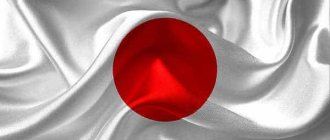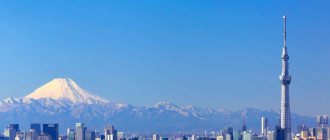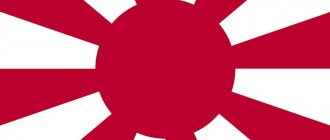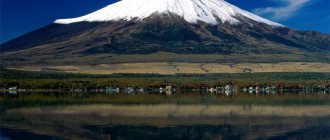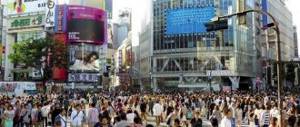The Japanese archipelago consists of hundreds of islands stretching from north to south. Such geography provides the country with climatic diversity, so there is no single concept of the Japanese climate. The climate in Japan varies significantly depending on the region. In January, when there is frost and snow in the north, sakura blooms in the southern regions, and the average temperature does not fall below 10-15 degrees Celsius.
A land of contrasts: frosts and subtropics
The climatic zones of Japan are strikingly diverse: almost all types of climate are represented here. The four main islands stretch from north to south for 3 thousand km: Hokkaido, Honshu, Kyushu, Shikoku. The northern part of Hokkaido is located in the subarctic zone, and the south of the country is already in the subtropics.
Since the country is surrounded on all sides by the ocean, the weather has its own characteristics. In winter, wet monsoons constantly blow from the Eurasian continent, bringing rain and snow to the western part of the archipelago. During this time, the eastern Pacific coast is mostly clear and dry.
Spring begins with strong winds blowing in February-March. These are the first signs of the spring season.
Climatic conditions on the largest islands - Honshu, Shikoku and Kyushu - are milder than in the north. Winters are warm, temperatures do not drop below zero, although there are heavy snowfalls. At the beginning of summer, monsoon rains begin, humidity reaches 100%.
From mid-summer to early autumn, temperatures reach +30 Celsius and above, attracting vacationers to the beaches. At the end of September the heat subsides and the number of tourists increases.
Typhoons, which appear from June to October, causing destruction and danger to people's lives, are considered a real disaster for the climate of the islands.
Typhoons
The southern part of Japan has a subtropical climate. And every year it is attacked by hurricanes. This mainly occurs in summer and early autumn. During the season, up to thirty typhoons are formed in the archipelago area, the wind speed at the epicenter of which can reach sixty meters per second.
Of these, up to four on average can reach hurricane strength. They rise north to the Japanese Islands. There have also been hurricanes with devastating consequences in the history of the country. In any case, almost every year for Japan they turn out to be a natural disaster with floods and forced relocation of people.
By the way, it is from the Japanese word “taifu” (which means “tropical cyclone”) that the international “typhoon” was formed. This unfavorable season ends for the Japanese in September.
Winter in Japan
The winter months are especially different from region to region. So, in Hokkaido, especially in the northern part of the island, there is a fairly severe snowy winter, and the temperature can drop to 15-20 degrees below zero.
It is quite warm in Honshu and Shikoku in December-January: +5…+7 degrees. The Ryukyu Islands and Okinawa are located in southern latitudes; a monsoon climate prevails here and the temperature rarely drops below 10-12 degrees Celsius.
The Pacific coast has a mild climate: with the onset of winter, the air temperature here drops, but it rarely drops below zero. At the same time, in Northern Japan, snow falls from the first days of December, which lies there throughout the winter; in the center of the country, precipitation is extremely rare, and in the south there is no snow at all.
When you come to Japan in winter, you can first go skiing in Sapporo, and then go to Okinawa and scuba dive.
The weather in Japan by winter months in the main cities of the country looks like this:
| December | January | February | |
| Tokyo | +8…+11 | +6…+9 | +8…+10 |
| Kyoto | +9…+11 | +5…+7 | +9…+11 |
| Osaka | +8…+10 | +5…+7 | +6…+8 |
| Nara | +5…+8 | +3…+6 | +4…+7 |
| Sapporo | -1… -2 | -2… -3 | -1… +1 |
Spring in Japan
The Japanese are careful about their weather, as it often brings them a lot of problems. So, everyone is looking forward to strong winds in February-March - they are the ones, according to old beliefs, that bring spring.
In general, spring in Japan is warm and sunny. Throughout the entire territory, except for the northern regions, already in March the temperature reaches +10, and in April on the large islands the air is filled with the fragrance of flowering apricot trees and the legendary sakura. This period is called Hanami.
Thanks to the huge extent of the country from north to south, you can watch the blossoming of these amazingly beautiful trees for several months: on the islands of Okinawa and Kyushu, sakura blooms at the end of February, in Tokyo and Kyoto it begins to bloom at the end of March, and in Hokkaido - at the end April - early May.
Thus, the whole spring in Japan passes under the sign of “Time of admiring flowers.” If you're deciding when to go to Japan, it's hard to find a better time. At the end of May the air warms up to + 25…+ 30 degrees.
In spring, temperature indicators for the main cities of the country look like this.
| March | April | May | |
| Tokyo | +9…+11 | +15…+18 | +18…+21 |
| Kyoto | +10…+12 | +15…+18 | +20…+23 |
| Osaka | +9…+12 | +14…+17 | +18…+22 |
| Nara | +7…+11 | +12…+16 | +17…+22 |
| Sapporo | +1…+3 | +7…+10 | +11…+14 |
Summer in Japan
The summer period begins exactly on schedule: at the beginning of June. It is from the first month of summer that the heat begins, but the rainy season in Japan also begins in June. It rains frequently, heavily, and can last for weeks.
The Japanese don't really like their summer: these are the months when deadly typhoons strike. Humidity increases to 100%, and the heat is set at +28...+30 degrees and above.
July is characterized by a decrease in the amount of rain, humidity also decreases - up to 90%.
July and August are the best time for a beach holiday: only on the coast do the Japanese and guests of the Land of the Rising Sun escape the tropical heat and humidity. There are many holidays and excursions held in the resort towns of Japan. Going on an ocean cruise on a boat, you can watch whales.
The average temperature in summer is as follows:
| June | July | August | |
| Tokyo | +20…+25 | +26…+30 | +28…+30 |
| Kyoto | +26…+27 | +29…+31 | +30…+32 |
| Osaka | +22…+25 | +26…+29 | +27…+30 |
| Nara | +20…+24 | +25…+28 | +25…+29 |
| Sapporo | +16…+20 | +21…+25 | +23…+27 |
Koromogae: Seasonal wardrobe changes
The custom of seasonally changing clothes, which exists not only in government institutions, but also in private firms and enterprises, as well as in schools where students wear uniforms according to the season, is called koromogae (Japanese: changing of dress). Almost everywhere in Japan there is a “transition” to summer clothes on the first of June, and to winter clothes on the first of October. Due to the hot and humid climate, as well as the lack of space in small Japanese apartments, with the arrival of the new season, warm clothes, coats and jackets are sent to the dry cleaners, and then, accompanied by moth repellent, into suitcases and plastic boxes to wait next winter. And their place in the closet is taken by light summer outfits taken from bags and cardboard boxes. The custom of changing clothes according to the season originated in Japan about a thousand years ago, during the Heian era (794-1185).
Seasonal change of dress: summer (left) and winter (right) school uniform
During the summer months, employees of Japanese companies, when going to work, dress in the cool biz style (lightweight business style), which is recommended by the Japanese Ministry of the Environment. For example, cool biz style does not involve wearing a tie. In summer, along with modern devices such as air conditioners, fans and neckerchiefs with a cooling element, traditional methods are also used for cooling: fans, bamboo blinds for shading, uchimizu (watering the asphalt with water from a ladle) and growing “living curtains” from climbing plants on the windows. Curtains with UV protection are also popular.
“Living curtain” - greenery on the window protects from direct sunlight entering the room
Thermal Insulation Adhesive Tape
When winter comes, heaters, stoves and kotatsu tables are taken out of storage. With special insulating adhesive tape, which can be bought at any stud store, cracks in window and balcony frames are sealed, a heat-insulating foil lining is placed under the carpet - all this is done for the sake of insulation. Japanese homes are also experiencing a “seasonal change of dress.”
Autumn in Japan
The first signs of the onset of autumn can be observed in late August - early September, when the air temperature gradually begins to decrease, remaining on average at a comfortable 25 degrees in most regions of the country. And although on some days in September the temperature sometimes reaches +28...+30 degrees, in October on some days the temperature in the capital no longer exceeds +13...+15 degrees.
Humidity drops in autumn, the picture of nature withering is pleasing to the eye, while the weather is mild and warm. Chrysanthemums are blooming, maple leaves are blazing with fire. Many travelers choose autumn for their trip, when the country looks especially attractive.
Autumn temperature indicators:
| September | October | November | |
| Tokyo | +25…+28 | +20…+23 | +15…+18 |
| Kyoto | +26…+29 | +20…+23 | +16…+18 |
| Osaka | +23…+26 | +18…+21 | +13…+15 |
| Nara | +21…+25 | +16…+20 | +11…+14 |
| Sapporo | +19…+22 | +12…+15 | +6…+8 |
When is the best time to go to Tokyo and Honshu Island?
It is best to come to Honshu in April-May to see sakura and wisteria bloom, and in October-November to admire the scarlet leaves of Japanese maples. You will bypass the summer heat and humidity in the fall, but you risk shelling out a decent amount for tickets and accommodation.
Tokyo is also good in the off-season. Although it seems that the weather does not particularly affect the study of local culture, shopping and nightlife in the capital, it still rains heavily in the summer.
You can make an exception and come to Honshu in the summer if you are passionate about conquering one of the main attractions of Japan - Fuji. The fact is that you can officially climb it only from July 1 to August 27. Guides and rescue services are only available during these two summer months, so Mount Fuji is closed to visitors at other times.
8 ways to see Tokyo from different angles
Cheap plane tickets to Tokyo
See hotels in Tokyo
When is the best time to visit Japan?
When choosing a time to travel to Japan, it is best to look at the map where exactly you are going.
The most popular excursions in Japan are during cherry blossoms - in spring. You can come to Okinawa at the end of February to admire this spectacle, when there is still snow on the main territory of Russia.
The beginning of summer is a rainy period, unfavorable for tourism. In July–August there is less rain, but it becomes too hot and stuffy.
Those who are interested in surfing come in the summer to the resort of Kamakura, the Ryukyu Islands, and Okinawa. Coral reef lovers gather on Keramo Island.
The best time to holiday in Japan, according to many, is mid-autumn. In October, festivals of music, dance, and traditional Japanese arts are held.
One of the most spectacular festivals, the Jidai Matsuri, is held in Kyoto every year on October 22. This is a festive costume procession, a historical reconstruction of the imperial procession, attracting numerous tourists.
Japan looks very beautiful on the eve of the Christmas and New Year holidays. The north of the country is covered with snow, but the weather is quite warm.
There are three popular ski areas in Hokkaido - Niseko, Furano and Rusutsu - with developed infrastructure and slopes for skiers of all levels.
Lovers of winter swimming in thermal springs near Mount Fuji also come to Japan.
When is the best time to go to Sapporo and Hokkaido?
Although Hokkaido is the northernmost island of the archipelago, winters here are quite mild, with temperatures around -5 °C. But there is a lot of snow. The ski season at local resorts lasts approximately from November to May . If you get tired of riding, you can always relax in the spa.
In the summer, Hokkaido is unbearably humid, so it’s better to enjoy walks through natural parks and sightseeing, and then relax and recuperate in the waters of thermal springs in the fall .
Find cheap flights to Sapporo
Cheap hotels in Sapporo
